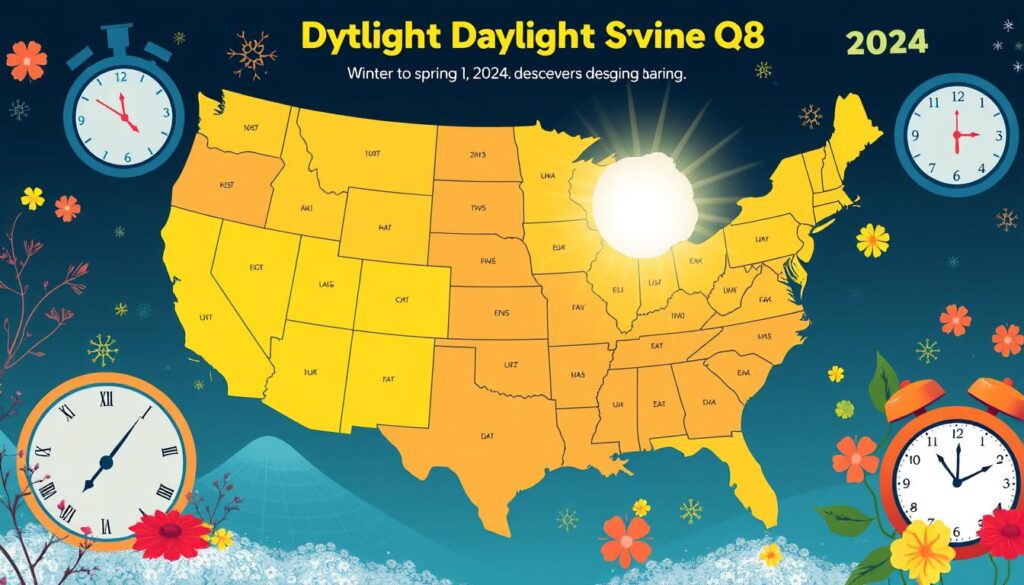In 2024, Daylight Saving Time starts on March 10. At 2:00 AM, we’ll set our clocks one hour ahead. This means it will suddenly be 3:00 AM. It allows us to enjoy more light in the evenings. Daylight Saving Time ends on November 3, 2024. We’ll turn our clocks back, making sunrise and sunset earlier.
Daylight Saving Time helps us use more daylight in the seasons. It’s not just in the United States but also in other countries. In 2024, the United States had seven time zones. The practice comes from laws like the Uniform Time Act of 1966. Another important one is the Energy Policy Act of 2005. These laws set the current Daylight Saving Time from March’s second Sunday to November’s first Sunday.
Key Takeaways
- Daylight Saving Time for 2024 begins on Sunday, March 10th at 2:00 AM.
- Clocks will spring forward by one hour, resulting in later sunsets.
- The DST schedule ends on Sunday, November 3rd, 2024.
- Arizona and Hawaii do not observe Daylight Saving Time.
- The USA has observed Daylight Saving Time for 107 years between 1918 and 2024.
What is Daylight Saving Time?
Daylight Saving Time, known as DST, lets us set our clocks one hour ahead in warm months. This extends evening daylight. The U.S. first adopted it in 1918. It helps us use natural light longer in the evening, cutting down on electric light use.
Definition and Purpose
DST means moving clocks forward in spring and back in fall. This change uses summer’s longer days well. With extra evening light, we use less electricity. This saves energy and lines up work times with daylight better.
History and Origin
DST’s idea goes back to the 1900s but got real during World War I. Benjamin Franklin first thought of it in 1784. The U.S. used it in 1918 to save fuel. After stopping, then starting again in World War II. In 1966, the Uniform Time Act made DST start and end the same time everywhere in the U.S.
How it Works
Daylight Saving Time gives us more light in the evening by changing the clock. In the U.S., clocks go forward one hour in March and back in November. For example, in 2024, it starts on March 10 and ends on November 3. This helps save on energy costs and suits our natural waking hours. Yet, it might be hard to adjust to for some people at first.
For questions about Daylight Saving Time, contact us.
Daylight Savings 2024 Key Dates
The United States follows a set pattern for daylight savings, with important dates to remember. Knowing these dates helps you adjust your schedule. It’s key for planning ahead.
When Does Daylight Saving Time Start?
Daylight Saving Time kicks off on Sunday, March 10, 2024. Clocks go forward one hour at 2 a.m., making evenings longer. This follows the Energy Policy Act of 2005, setting this date annually.
When Does Daylight Saving Time End?
2024’s Daylight Saving Time ends on Sunday, November 3. Clocks roll back one hour at 2 a.m., closing DST for the year. This shift allows for an extra hour of sleep, aligning with the Energy Policy Act.
Important Changes to Note
Adjusting to Daylight Saving Time impacts our daily lives. Health experts believe changing clocks can disturb our natural rhythms. This may increase risk of heart attacks, strokes, and sleep problems.
Attempts to reform DST include the U.S. Senate’s 2022 vote for permanent daylight saving. Yet, it didn’t pass in the U.S. House. Senator Marco Rubio also pushed the Sunshine Protection Act of 2023, sparking debates on DST’s future.
Why Do We Observe Daylight Saving Time?
Daylight Saving Time (DST) is often debated. Yet, it aims to save energy and make better use of daylight.
Energy Conservation
Since World War I, Daylight Saving Time has helped us save coal and energy. It means less need for lights and heating in the evening. This can significantly cut down on electricity use.
Longer evening daylight with DST could improve safety, activities, and save power. A 2022 CBS News/YouGov poll showed nearly 80% of Americans want changes to DST.
Historical Reasons
Introduced in 1918, Daylight Saving Time aimed to save fuel during World War I. This practice has also helped during other crises. It’s all about using natural light wisely.
The idea began as a wartime effort but has grown. The Uniform Time Act of 1966 keeps it regulated in American life.
Current Relevance
Today, Daylight Saving Time’s impact is debated. Yet, many see it as key for saving energy. It means more daylight in the evening for outdoors, shopping, and boosting the economy.
Legislative efforts like Senator Marco Rubio’s Sunshine Protection Act want to keep DST all year. But current laws don’t allow it to be permanent. The debate is ongoing between sleep experts and economists.
DST is a mix of tradition, energy-saving, and modern benefits in the U.S. It has a rich history and remains relevant, affecting our daily life.
| Aspect | Details |
|---|---|
| Start Year | 1918 |
| Duration in 2024 | 238 days |
| Public Opinion | 80% of Americans support changing the system |
| Current Legislation | Sunshine Protection Act (yields no recent activity in 2024) |
| Energy Savings | Reduction in lighting and heating usage |
Which States Observe Daylight Saving Time in 2024?
In 2024, many U.S. states will follow Daylight Saving Time (DST), adjusting clocks as planned. Arizona and Hawaii, along with territories like Puerto Rico and Guam, do not observe it. Following DST impacts daily life and business, making operations smooth in line with the Energy Policy Act adjustments.
States will set clocks forward one hour on the second Sunday in March. They’ll turn them back on the first Sunday in November. California, Texas, New York, and others stick to this, ensuring seamless time changes.

| State | DST Start | DST End |
|---|---|---|
| California | March 10 | November 3 |
| Texas | March 10 | November 3 |
| Florida | March 10 | November 3 |
| New York | March 10 | November 3 |
| Illinois | March 10 | November 3 |
Many states, including Alabama and Colorado, want to stick with DST all year, waiting for Congress to agree. The 2024 DST timeline is designed to extend daylight time. This fits with historic practices and efforts to save energy.
If you’re looking to enjoy luxury travel affordably during these time changes, check out these smart travel tips and destinations.
States That Do Not Observe Daylight Saving Time
Most of the United States changes their clocks for Daylight Saving Time. However, Arizona and Hawaii do not. These places, along with some U.S. territories, stick to standard time all year. This decision is based on their unique geographical and cultural reasons.
Arizona
Arizona doesn’t follow Daylight Saving Time, except within the Navajo Nation. This practice is known as Arizona DST. The state enjoys plenty of sunshine year-round.
By ignoring DST, Arizona avoids making its hot summers even hotter for its residents.
Hawaii
Since 1967, Hawaii has not participated in Daylight Saving Time. The state has consistent sunrise and sunset times.
Therefore, changing the clocks for Hawaii daylight savings isn’t really helpful. Hawaii sticks to standard time throughout the year.
U.S. Territories
Several U.S. territories also skip Daylight Saving Time. This group includes Puerto Rico, the Northern Mariana Islands, the U.S. Virgin Islands, American Samoa, and Guam. These places have steady tropical climates and little change in daylight length.
Thus, keeping US Territories standard time makes sense for them. It’s more suitable given their conditions.
Benefits of Daylight Saving Time
Daylight Saving Time (DST) brings many advantages that energize communities and boost well-being. These benefits help us understand the debate around DST.
Energy Savings
DST can save energy. By having more daylight in the evening, we use less artificial light. A report by the Department of Energy in 2008 found a 0.5% drop in daily electricity use due to DST. Though a 2011 study in Indiana showed mixed results, using natural daylight aims to save energy. This was a key reason for starting DST during World War I.

Extended Daylight in Evenings
Extended evening daylight is a top benefit of DST. It matches our active hours, encouraging outdoor activities. This is good for our health and happiness. For instance, the extra month of DST in 1986 was worth a lot to golf and BBQ businesses, about $200 million to $400 million. Also, the Association for Convenience and Fuel Retailing said the extra DST month added $1 billion in sales in 1986. So, longer evenings positively affect our leisure and economy.
Reduced Traffic Accidents
Improved safety from DST is key. More daylight in the evening means fewer traffic accidents. Studies show that better visibility during busy driving times makes roads safer. This makes a big difference in public safety and health.
Below is a table summarizing key dates for DST in 2024:
| Event | Date | Details |
|---|---|---|
| Start of DST | March 10, 2024 | Clocks moved forward one hour |
| End of DST | November 3, 2024 | Clocks moved back one hour |
Despite debates, DST’s benefits like energy savings, more daylight, and safety continue to shape its use.
Drawbacks of Daylight Saving Time
Daylight Saving Time (DST) is often praised but has downsides. It affects sleep, health, and even the economy. These problems lead to debates about its value and future.
Sleep Disruption
Sleep patterns get disrupted by DST, affecting our internal clocks. This leads to tiredness and less sharp thinking. A study in 2015 found students were more tired and not as focused after the clock change.
American Academy of Sleep Medicine surveys show that 55% of Americans feel more tired after DST starts. Experts say it can take over a week to adjust to the new time.
Health Effects
DST doesn’t just make you sleepy; it can harm your health. Studies link the time change to more heart attacks and strokes. There’s also a spike in inflammation, raising cardiovascular risk.
A study from 2020 points out that DST can worsen depression and anxiety. Over 60% of Americans would rather stop changing the clocks, suggests the American Academy of Sleep Medicine. Read more about the health effects of.
Economic Impacts
The economic effects of DST spark debate too. Although it aimed to save energy originally, that goal seems harder to reach now. Consumer habits and energy use patterns have shifted, lessening the energy savings.
A 2020 study links DST to a 6% rise in deadly traffic accidents. This increases healthcare costs and lowers work productivity. Over 30 states are considering a single, stable time to avoid DST’s drawbacks.
The debate on keeping or ditching DST is ongoing. For more insights, check here for additional research and opinions.
Tips for Adjusting to Daylight Savings Time
Daylight Saving Time (DST) starts on March 10th, 2024. It’s important to get ready for a smooth shift. These tips will help your sleep schedule adjust without trouble.
Gradual Adjustment Tips
To adapt to daylight savings, shift your bedtime gradually. A week before the change, go to bed 10-15 minutes earlier each night. It makes the shift easier and avoids major sleep disruptions.
- Aim to go to bed 10-15 minutes earlier each night.
- Dim the lights and reduce blue light exposure in the evening.
- Avoid heavy meals and caffeine close to bedtime.
Maintaining Consistent Sleep Schedule
Keeping a consistent sleep schedule helps your internal clock. Wake up and sleep at the same times daily, including weekends. This consistency eases the adjustment to DST changes.
Tips for Consistent Sleep Schedule:
- Stick to a regular sleep-wake cycle.
- Follow a relaxing bedtime routine to signal it’s sleep time.
- Avoid naps, especially in the afternoon.
Staying Healthy During the Transition
Staying healthy during DST is key. Exercise regularly, eat well, and get morning sunlight. These habits support an easier DST adjustment.
| Activity | Benefit |
|---|---|
| Regular Exercise | Improves sleep quality and overall health. |
| Balanced Diet | Provides essential nutrients for better sleep. |
| Morning Sunlight | Helps reset the body’s internal clock. |
To minimize DST’s impact, adjust gradually, keep a consistent sleep schedule, and focus on health. These steps ensure a smooth transition and healthy adjustment.
Historical Changes and Controversies
The history of Daylight Saving Time (DST) is filled with many changes and debates. It has evolved from wartime adjustments to modern discussions in the legislature.
Significant Changes in DST Policies
In World War II, daylight saving was used nationwide from February 9, 1942, to September 30, 1945. The Uniform Time Act of 1966 made the start and end dates the same across the U.S. It also allowed for local exceptions. During the 1970s, there was a temporary change to save energy, with DST starting on January 6, 1974, and February 23, 1975.
By 1986, the law changed to start DST on the first Sunday in April, beginning in 1987. The Energy Policy Act of 2005 then shifted the start to the second Sunday in March. It also extended DST to the first Sunday in November, starting in 2007.
Public Opinion and Debates
People have mixed feelings about DST. A 2023 YouGov poll showed 62% of Americans want to stop changing clocks. Yet, only half support permanent daylight saving time. The American Academy of Sleep Medicine found 63% favor ending seasonal time changes. The AP-NORC Center shows only 25% like the current system of changing clocks twice a year.
In response, lawmakers have taken action. Colorado’s Governor Jared Polis signed a bill for year-round DST, waiting on federal approval. By 2023, 29 states were considering DST bills. States like Massachusetts, Maine, and Minnesota are looking at permanent standard time.
Deciding on daylight saving is not simple. With 40% of Americans preferring standard time all year and 31% for year-round DST. The economic effects, like the $36.4 billion from Denver International Airport, make the debate even more complex. This is especially true if not all states agree.
Interesting Facts About Daylight Saving Time
Many people think Daylight Saving Time (DST) was made to help farmers. That’s not true. Actually, it disrupts farmers’ work schedules. DST started during World War I and II to save energy. Let’s look at some interesting DST facts, its worldwide use, and how it affects nature.
Common Myths
A lot of myths surround Daylight Saving Time. One big myth is it was for farmers’ benefit. In fact, it was to save fuel in wartime. Some believe longer daylight saves energy. But, studies show mixed findings about energy saving.
Global Observance
More than 70 countries observe DST, which is less than 40% of the world. Many European countries like the United Kingdom and Germany do it. In the U.S., Hawaii and most of Arizona skip it. Seeing how different countries use DST shows the variety in handling daylight hours.
Effect on Natural Phenomena
DST also changes how wildlife behaves and plants grow. Animals and birds change their schedules with the daylight. Research is looking into how DST affects nature. It’s giving us important information on nature’s response to time changes.

